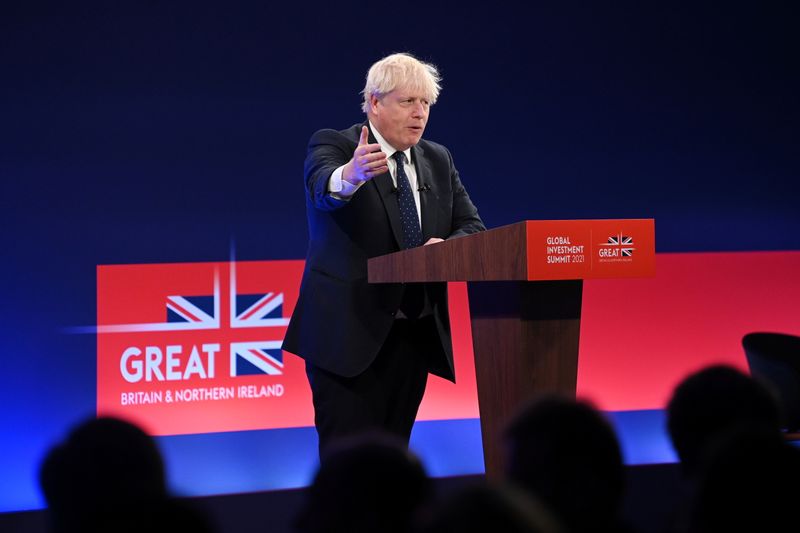LONDON (Reuters) -British Prime Minister Boris Johnson set out his ambition on Tuesday for a green revolution that he hopes will force countries around the world to kick their addiction to fossil fuels and commit to net zero carbon emissions.
Britain at the end of the month hosts the COP26 U.N. climate talks in Glasgow, Scotland, which aim to strengthen global action on climate change.
“With the major climate summit COP26 just around the corner, our strategy sets the example for other countries to build back greener too as we lead the charge towards global net zero,” Johnson said.
Johnson, who once expressed scepticism about climate change, presented his 368-page net zero strategy as a document that would put the UK at the vanguard of green economies.
“The UK leads the world in the race to net zero,” he said in the foreword to the ‘Net Zero Strategy: Build Back Greener’.
“The likes of China and Russia are following our lead with their own net zero targets, as prices tumble and green tech becomes the global norm,” he said.
In 2019, Britain became the first member of the Group of Seven major industrialised economies to set a net zero emissions target for 2050, which will require drastic changes in the way Britons travel, heat their homes and consume electricity.
The strategy is a series of long-term promises, some with caveats, to shift the world’s fifth largest economy towards green technologies, including moving to clean electricity and low-carbon heating in British homes.
It aims to secure 440,000 jobs and unlock 90 billion pounds ($124 billion) of private investment by 2030.
It also aims to help Britain gain a competitive edge in low-carbon technologies such as heat pumps, electric vehicles, carbon capture and storage and hydrogen.
The government targets being powered entirely by clean electricity, “subject to security of supply”, by 2035. It aims to have 40 gigawatts (GW) of offshore wind power by 2030, as well as 1 GW of floating offshore wind.
As of the end of last year, renewables accounted for around 40% of total electricity generated in Britain, with wind energy supplying around 24% of that.
LOW-CARBON SHIFT
“The strategy should generate a new and attractive form of growth, but the investments have to be fostered, and some households, particularly low-income ones, will need some help,” said Nicholas Stern, climate economist and chair of the Grantham Research Institute on Climate Change and the Environment.
“Most of the investment will be by the private sector and it is very important that the right kind of incentives and risk management are generated through private-public partnership.”
Earlier on Tuesday, Johnson announced nearly 10 billion pounds of private investment in green projects at an investment summit in London.
The government plans to deliver 5 GW of hydrogen production capacity by 2030, while cutting its emissions from oil and gas by half.
It wants to deliver four carbon capture storage and usage (CCUS) clusters, capturing 20-30 million tonnes of carbon dioxide (CO2) across the economy per year by 2030.
The government also aims to deploy at least 5 million tonnes of CO2 a year of engineered greenhouse gas removals by 2030.
The strategy said current gas price spikes underline the need to move away from fossil fuels as quickly as possible, but the transition has to be managed in a way which protects jobs, investment and guarantees security of supply.
In the wholesale market, the price of gas, the fuel the UK relies on for the majority of its heating, has risen by over 250% this year, forcing some energy suppliers out of business and boosting consumer energy bills.
Simone Rossi, chief executive of EDF in the UK, which operates the country’s nuclear plant fleet, said: “Rising gas prices are putting pressure on people’s energy bills now, so we need to make urgent progress with building proven, low carbon energy generation that keeps costs steady and supplies secure.”
Many of the UK’s nuclear plants are ageing. Some are being decommissioned earlier than scheduled and EDF’s new Hinkley Point C plant will not be online until 2026.
EDF also plans to build a plant at Sizewell in Suffolk subject to the right investment framework.
The Johnson government said it would secure a final investment decision on a large-scale nuclear plant by the end of this parliament.
It will also launch a new 120 million pound “future nuclear enabling fund” for future nuclear technologies, including small modular reactors, with a number of potential sites such as Wylfa in north Wales.
($1 = 0.7243 pounds)
(Reporting by Guy Faulconbridge, Kate Holton and Nina Chestney; editing by Alistair Smout, Jason Neely and Gareth Jones)



















